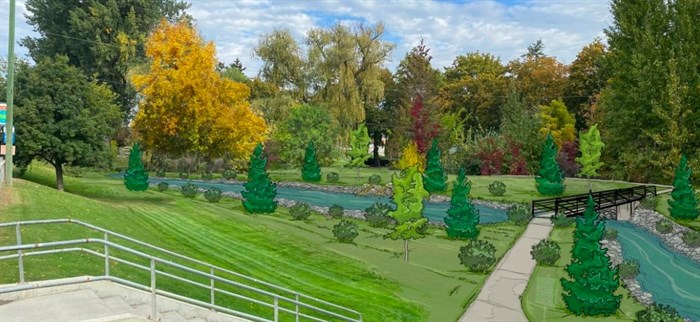
Vernon Creek in Polson Park.
Image Credit: Submitted/City of Vernon
August 13, 2023 - 7:00 PM
Back in the day, the smart people thought putting creeks into narrow channels was a good thing for preventing floods.
But times have changed and experts now realize that, in places like Vernon Creek running through Polson Park next to Highway 97 or Mission Creek through Kelowna, the opposite is true.
“The channelization of Vernon Creek within Polson Park was likely constructed in a number of stages starting in the 1950s,” says a report on naturalization plans for the park on the City of Vernon’s website.
“Channelizing, straightening and armoring with concrete barriers was a common practice in prior years. However, it’s now better understood that channelizing water courses can have significant negative impacts on the water systems and species that rely on them.
“Studies have shown that these concrete sections act as barriers to groundwater, causing groundwater to sit closely to the surface, causing surface ponding in some areas.”
Ponding and flooding have been expensive to deal with and led to the closing of the splash park in 2019 and its removal in 2021.
“In 2018, the City undertook a hydrogeology study and determined that the concrete barriers and duck pond likely attributed to these high groundwater levels,” the website says. “In June 2020, Vernon Creek spilled its banks in Polson Park, overtopping several bridges and flooding parking lots and roadways. Areas within the park were closed for several weeks until waters receded and saturated soils could dry out.”
The City of Vernon plans to change all of that with a two-phase, multi-year naturalization program.
“Naturalization of the channel includes removal of the existing concrete barriers, concrete duck ponds and lengthening the channel by meandering it along its current course,” the website says. “Removing the concrete channel and concrete duck ponds will also allow groundwater to naturally migrate towards Vernon Creek.”
The first phase, scheduled to start next summer, will run from Highway 97 to the duck pond outflow into the creek.
“Phase 1 will include removal of the existing concrete banks and elongating the channel by meandering it along its current course, lengthening the channel,” the website says. “Naturalization will also add natural features within the meandering channel such as riffle pools and boulders, which will increase natural fish/spawning habitat where there is currently very little.”

This is a rendering of what it will look like after being naturalized.
Image Credit: Submitted/City of Vernon
Right now the water rushes through the channel at such a fast rate that there are no places for spawning fish to rest and nowhere to spawn.
It’s expected that, once done, Kokanee, sockeye salmon and rainbow trout will be able to swim up and spawn in the creek.
Work will include creating a floodplain on either side of the main channel with shallow slopes and natural vegetation to accommodate future flooding and reduce bank erosion.
READ MORE: iN PHOTOS: More of Penticton Creek's concrete channel being turned into ideal fish habitat
Every effort will be made to retain existing large trees but some will likely have to be removed and other trees planted to replace them.
Plans call for existing crossings to be removed and two or three new crossings built along with a new pathway on the south side of the creek.
A contractor is expected to be hired in October with work on Phase 1 to run from July to November 2024.
It’s to be funded from the city’s Casino Grants Reserve.
Phase 2 will go from the duck ponds to the existing maintenance vehicle crossing near the south end of the park. No dates for that work are posted on the website.
Planning work is also expected to start this year on future changes to Polson Park as a whole.
Further to the south, Mission Creek in Kelowna is the largest single source of water to Okanagan Lake. It was channelized as well, following the 1948 flood. Its berms are rock and dirt.
READ MORE: Mission Creek restoration project begins Monday in Kelowna
Before that channelization, around one million kokanee spawned in the creek each year. By the late 1990s that had dropped to less than 1,000, according to a Mission Creek restoration website.
In 1998, a one-kilometre spawning channel was built in Mission Creek Regional Park and, in 2015 work began on naturalizing a 540-metre stretch of the creek between Gordon Drive and Casorso Road.
Long range plans call for the naturalization work to continue from Okanagan Lake for 12 km upstream to the East Kelowna Road bridge over Mission Creek.
Work on ripping out the concrete and restoring Penticton Creek started in 2015 and continued in 2018 and last year.
For more on the Vernon Creek naturalization project, go here.
To contact a reporter for this story, email Rob Munro or call 250-808-0143 or email the editor. You can also submit photos, videos or news tips to the newsroom and be entered to win a monthly prize draw.
We welcome your comments and opinions on our stories but play nice. We won't censor or delete comments unless they contain off-topic statements or links, unnecessary vulgarity, false facts, spam or obviously fake profiles. If you have any concerns about what you see in comments, email the editor in the link above. SUBSCRIBE to our awesome newsletter here.
News from © iNFOnews, 2023